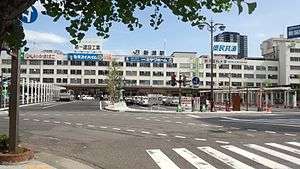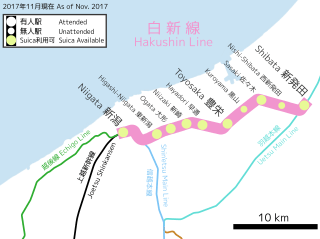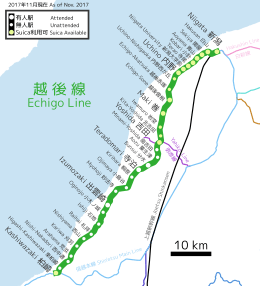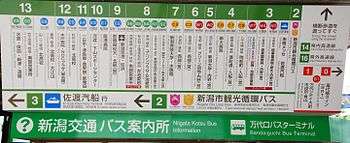Niigata Station
Niigata Station (新潟駅, Niigata-eki) is a major railway station in Chūō-ku, Niigata, Japan, operated by East Japan Railway Company (JR East).[1] The station is at the centre of Niigata city, the largest city on the Sea of Japan coast in Honshu. It forms the central station for the railway infrastructure along the Sea of Japan coast, and is also the terminus of the Jōetsu Shinkansen high-speed line from Tokyo.
Niigata Station 新潟駅 | |||||||||||||||||||||||||||||||||||||
|---|---|---|---|---|---|---|---|---|---|---|---|---|---|---|---|---|---|---|---|---|---|---|---|---|---|---|---|---|---|---|---|---|---|---|---|---|---|
 View of the station from the Bandai exit in June 2015 | |||||||||||||||||||||||||||||||||||||
| Location | 1 Hanazono, Chūō-ku, Niigata-shi, Niigata-ken 950-0086 Japan | ||||||||||||||||||||||||||||||||||||
| Coordinates | 37°54′43.3″N 139°3′42.8″E | ||||||||||||||||||||||||||||||||||||
| Operated by | |||||||||||||||||||||||||||||||||||||
| Line(s) |
| ||||||||||||||||||||||||||||||||||||
| Platforms | 2 side + 4 island platforms | ||||||||||||||||||||||||||||||||||||
| Connections | Bus terminal | ||||||||||||||||||||||||||||||||||||
| Other information | |||||||||||||||||||||||||||||||||||||
| Status | Staffed ("Midori no Madoguchi" ) | ||||||||||||||||||||||||||||||||||||
| Website | Official website | ||||||||||||||||||||||||||||||||||||
| History | |||||||||||||||||||||||||||||||||||||
| Opened | 3 May 1904 | ||||||||||||||||||||||||||||||||||||
| Traffic | |||||||||||||||||||||||||||||||||||||
| Passengers (FY2017) | 37,461 daily | ||||||||||||||||||||||||||||||||||||
| Services | |||||||||||||||||||||||||||||||||||||
| |||||||||||||||||||||||||||||||||||||
| Location | |||||||||||||||||||||||||||||||||||||
 Niigata Station Location within JR Shinetsu Main Line  Niigata Station Niigata Station (JR Hakushin Line)  Niigata Station Niigata Station (JR Echigo Line)  Niigata Station Niigata Station (BRT Bandai-bashi Line)  Niigata Station Niigata Station (Japan) | |||||||||||||||||||||||||||||||||||||
Lines
Niigata Station is served by the following lines.
- Joetsu Shinkansen
- Shin'etsu Main Line
- Hakushin Line
- Echigo Line
Station layout
The station has two side platforms (former 1, 4) and two island platforms (former 2/3, and 8/9) at ground level serving a total of six tracks for conventional narrow gauge lines, of which only one island platform remains in use for trains originating from Niigata Station. This island platform (8/9) is an extension of one of the side platforms (1). The station also has two elevated side platforms 2, 5) and one island platform 3,4) serving conventional narrow gauge lines, and two more elevated island platforms serving four shinkansen tracks (11 to 14). The elevated station building has a "Midori no Madoguchi" staffed ticket counter and "View Plaza" travel agency.[1]
 Gate (Bandai Entrance)
Gate (Bandai Entrance) Ticket machines (Bandai Entrance)
Ticket machines (Bandai Entrance) Elevated platforms
Elevated platforms Ground level platform No.8 and No.9
Ground level platform No.8 and No.9 Ground level platform No.1 (not in use)
Ground level platform No.1 (not in use) Sake Museum Ponshu-kan
Sake Museum Ponshu-kan
Platforms
(Elevated)
| 1 | ■ - | (facilities not yet in place) |
| 2-5 | ■ Shinetsu Line | for Niitsu, Nagaoka, and Tsugawa |
| ■ Ban'etsu West Line | for Gosen and Aizu-Wakamatsu | |
| ■ Hakushin Line | for Shibata and Murakami | |
| ■ Uetsu Main Line | for Shibata and Murakami | |
| ■ Echigo Line | for Yoshida and Kashiwazaki | |
| 11-14 | ■ Joetsu Shinkansen | for Takasaki, Ōmiya, and Tokyo |
(Ground level)
| former 1-4 | ■ - | (not in use) |
| former 5-7 | ■ - | (facilities removed) |
| 8-9 | ■ Shinetsu Line | for Niitsu, Nagaoka, and Tsugawa (starting trains) |
| ■ Ban'etsu West Line | for Gosen and Aizu-Wakamatsu (starting trains) | |
| ■ Hakushin Line | for Shibata and Murakami (starting trains) | |
| ■ Uetsu Main Line | for Shibata and Murakami (starting trains) |
History
Niigata Station opened on 3 May 1904.[1] With the privatization of Japanese National Railways (JNR) on 1 April 1987, the station came under the control of JR East.
Passenger statistics
In fiscal 2017, the station was used by an average of 37,461 passengers daily (boarding passengers only).[2] The passenger figures for previous years are as shown below.
| Fiscal year | Daily average |
|---|---|
| 2000 | 36,894[3] |
| 2001 | 37,185[4] |
| 2002 | 37,407[5] |
| 2003 | 37,612[6] |
| 2004 | 36,300[7] |
| 2005 | 37,050[8] |
| 2006 | 36,769[9] |
| 2007 | 36,849[10] |
| 2008 | 37,012[11] |
| 2009 | 36,396[12] |
| 2010 | 36,269[13] |
| 2011 | 36,711[14] |
| 2011 | 37,446[15] |
Surrounding area
- CoCoLo Niigata, shopping center in the station
- Sake Museum Ponshu-kan


- Bandai Bridge
Bus terminals

Both the Bandai Entrance and the South Entrance have bus terminals.[16][17] As of February 2017, the following transit bus line are on service.
Bandaiguchi Bus Terminal
- Niigata City Loop Bus[18][19]
- Transit bus operated by Niigata Kotsu[20]
- BRT "Bandai-bashi Line" : Niigata Sta.—Bandai Bridge—Furumachi—City office—Hakusan Station—Aoyama
- C* : for Central Niigata[21]
- S* : for South Niigata[22]
- W* : for West Niigata[23]
- E* : for East Niigata[24]
- "Sado-Kisen Line" : Niigata Sta.—Toki Messe—Sado Kisen Ferry Terminal
Minamiguchi Bus Terminal
- Transit bus operated by Niigata Kotsu
- Limousine bus for Niigata Airport
- C* / S* / W* / E*
References
- 各駅情報(新潟駅) [Station Information: Niigata Station] (in Japanese). Japan: East Japan Railway Company. Retrieved 10 September 2012.
- 各駅の乗車人員 (2017年度) [Station passenger figures (Fiscal 2017)] (in Japanese). Japan: East Japan Railway Company. 2018. Retrieved 11 September 2018.
- 各駅の乗車人員 (2000年度) [Station passenger figures (Fiscal 2000)] (in Japanese). Japan: East Japan Railway Company. Retrieved 10 September 2012.
- 各駅の乗車人員 (2001年度) [Station passenger figures (Fiscal 2001)] (in Japanese). Japan: East Japan Railway Company. Retrieved 10 September 2012.
- 各駅の乗車人員 (2002年度) [Station passenger figures (Fiscal 2002)] (in Japanese). Japan: East Japan Railway Company. Retrieved 10 September 2012.
- 各駅の乗車人員 (2003年度) [Station passenger figures (Fiscal 2003)] (in Japanese). Japan: East Japan Railway Company. Retrieved 10 September 2012.
- 各駅の乗車人員 (2004年度) [Station passenger figures (Fiscal 2004)] (in Japanese). Japan: East Japan Railway Company. Retrieved 10 September 2012.
- 各駅の乗車人員 (2005年度) [Station passenger figures (Fiscal 2005)] (in Japanese). Japan: East Japan Railway Company. Retrieved 10 September 2012.
- 各駅の乗車人員 (2006年度) [Station passenger figures (Fiscal 2006)] (in Japanese). Japan: East Japan Railway Company. Retrieved 10 September 2012.
- 各駅の乗車人員 (2007年度) [Station passenger figures (Fiscal 2007)] (in Japanese). Japan: East Japan Railway Company. Retrieved 10 September 2012.
- 各駅の乗車人員 (2008年度) [Station passenger figures (Fiscal 2008)] (in Japanese). Japan: East Japan Railway Company. Retrieved 10 September 2012.
- 各駅の乗車人員 (2009年度) [Station passenger figures (Fiscal 2009)] (in Japanese). Japan: East Japan Railway Company. Retrieved 10 September 2012.
- 各駅の乗車人員 (2010年度) [Station passenger figures (Fiscal 2010)] (in Japanese). Japan: East Japan Railway Company. Retrieved 10 September 2012.
- 各駅の乗車人員 (2011年度) [Station passenger figures (Fiscal 2011)] (in Japanese). Japan: East Japan Railway Company. Retrieved 10 September 2012.
- 各駅の乗車人員 (2015年度) [Station passenger figures (Fiscal 2015)] (in Japanese). Japan: East Japan Railway Company. 2016. Retrieved 5 July 2016.
- 新潟駅前周辺バスのりば [Bus stop map around Bandai Entrance] (PDF) (in Japanese). Niigata Kotsu. Retrieved 3 February 2017.
- 新潟駅南口バスのりば [Bus stop map around South Entrance] (PDF) (in Japanese). Niigata Kotsu. Retrieved 3 February 2017.
- "Niigata City Loop Bus Map (2016.3- )" (PDF). Niigata City. Retrieved 3 February 2017.
- "Niigata City Loop Bus Timetables (2016.3- )" (PDF). Niigata City. Retrieved 3 February 2017.
- 運行便別時刻表 [Bus Lines and Timetables (2016.11- )] (in Japanese). Niigata Kotsu. Retrieved 3 February 2017.
- 路線図(中心部) [Bus Map for East Niigata (2016.11- )] (PDF) (in Japanese). Niigata Kotsu. Retrieved 3 February 2017.
- 路線図(南方面) [Bus Map for East Niigata (2016.11- )] (PDF) (in Japanese). Niigata Kotsu. Retrieved 3 February 2017.
- 路線図(西方面) [Bus Map for East Niigata (2016.11- )] (PDF) (in Japanese). Niigata Kotsu. Retrieved 3 February 2017.
- 路線図(東方面) [Bus Map for East Niigata (2016.11- )] (PDF) (in Japanese). Niigata Kotsu. Retrieved 3 February 2017.
External links
| Wikimedia Commons has media related to Niigata Station. |
- JR East station information (in Japanese)

